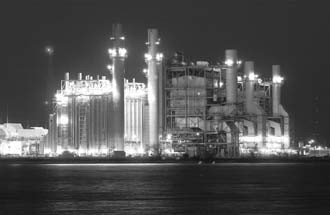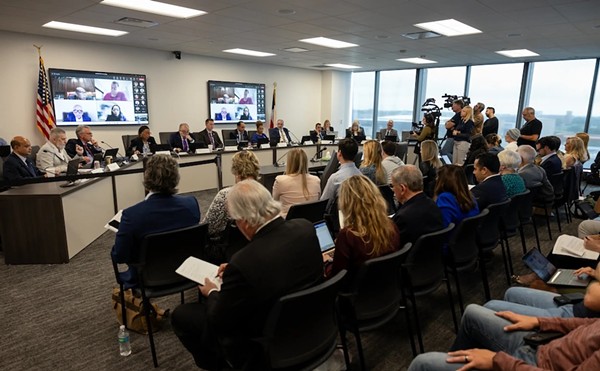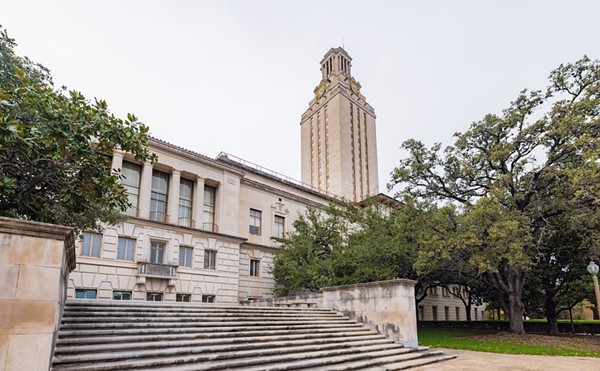|
CPS' coal plant fuels debate about energy policy Drive through rural southeastern Bexar County and you can see City Public Service's coal- and gas-fired power plants puffing smoke and steam over the skyline. Within the next five years, the municipally owned utility could add another smokestack to the horizon if its proposal for a third coal-fired power plant clears the state's environmental agency - and public scrutiny. A public meeting, scheduled for December 16, is part of the ongoing debate that began in 2003, when CPS announced its plans to build the new, $1 billion, 750-megawatt plant. Over the past 18 months, citizens have packed several public meetings and sent hundreds of comments about energy conservation, renewable energy, and the health and environmental effects of power plant emissions to the Texas Commission on Environmental Quality. The drama within the federal government adds another dimension to San Antonio's energy policy: the Bush administration's bias toward fossil fuels, proposed weak rules governing mercury emissions, and budget cuts in conservation and renewable programs. Joe Fulton, CPS' director of research and environmental management, claims the new plant will be the "best-controlled in the United States," and will not significantly add to existing emissions from the Deely and Spruce units. Moreover, CPS is investing in $350 million in upgrades at those older plants to further reduce amounts of the nastiest emissions - sulfur dioxide, nitrogen oxide, mercury, and particulate matter - released into the air. Most of these improvements should be in place before the new unit starts producing power in 2009. The net result, Fulton says, "is to keep levels no higher than they are now." "Some opponents say we're adding emissions," he adds, referring primarily to the Public Citizen and SEED Coalition, two environmental groups with offices in Austin. "With the new unit we're going to reduce overall emissions by 60 percent." Smart Growth San Antonio has also announced it opposes the new plant, emphasizing that air pollution contributes to global warming. Tom "Smitty" Smith, director of Public Citizen's Austin office applauded CPS for reducing emissions, but cautioned that, "Even with those cuts, San Antonio will have a hard time meeting its emissions goals because of traffic and other sources. If we didn't build plant we'd have a margin for error and be able to attract new industry. We don't need the plant."
The TCEQ has preliminarily okayed CPS' draft permit, and if the commission gives it a final approval, it would be the first coal-fired plant to be green-lighted since CPS' Spruce unit in 1989. "Energy moves in cycles," says Eric Hendrickson, TCEQ Air Permitting Combustion team leader. "President Carter's energy policy said to develop coal; that trickle effect went on into the '80s. There is renewed interested because coal is cheap." With the public hearing just two weeks away, environmental activists are pushing CPS to increase its investment in renewables and conservation. "Energy efficiency is a lower cost alternative than new plants in many cities," said Smith. Analyzing a CPS-commissioned energy efficiency study, Public Citizen concluded that San Antonio doesn't need the new power plant because by upping its investment in energy efficiency for homes, the utility could save more than 1,200 megawatts of energy over the next 10 years, nearly twice the output of the proposed unit. The study was conducted by Wisconsin-based KEMA and analyzed technically and economically feasible energy conservation programs. Through conservation in commercial and residential buildings, from 1982-2002 Austin saved 510 megawatts, about half the amount of the proposed plant. Fulton cites CPS programs, including compact fluorescent bulbs, programmable thermostats, and rebates for energy-efficient air conditioners as evidence the utility is committed to conservation. And 4 percent of its energy portfolio comes from wind power, although he emphasized it is not always a reliable source of energy. San Antonio's energy predicament mirrors the federal level, in which President Bush, a friend to big energy, is emphasizing fossil fuels over conservation and renewables. This policy is born out in the proposed weak mercury rules and the Fiscal Year 2005 budget, which cut solar energy programs by $3 million and overall energy and efficiency and conservation by $2 million, while increasing the president's Coal Research Initiative by $69 million. As for mercury, in 2001 all CPS plants emitted a total of 703 pounds into the air, although Fulton says CPS might have overestimated that amount because some mercury emissions were being filtered out by new technology used for other pollutants. The new plant could emit about 140 pounds a year, according to TCEQ estimates, although the SEED Coalition estimates it could be as much as 380 pounds.
Nonetheless, the EPA delayed issuing mercury rules for power plants from this month to March 2005 after evidence emerged that when writing the proposed rules, it had cribbed language from comments submitted by utility industry lobbyists. The Bush administration is pushing a cap-and-trade plan, allowing dirtier utilities to buy mercury credits from less polluting ones. Similar programs exist for sulfur dioxide, which is less toxic than mercury. Fulton says CPS sent comments to the EPA opposing cap-and-trade programs in favor of Maximum Achievable Control Technology also known as MACT, that reduces emissions by 85 to 90 percent. "We think it's better for us and the country to use MACT. It's not feasible for a municipal utility to participate in a trade program." CPS has sold sulfur dioxide credits, but does not buy them. To do so would mean spending taxpayer dollars to subsidize pollution. Karen Hadden, director of the SEED Coalition, says she welcomes additional pollution controls, but with a caveat. "We're glad that CPS has agreed to meet the coming federal standards, but the truth is that no additional mercury is acceptable." Absent strong federal rules, Texas could follow Massachusetts' lead, which in May enacted the toughest mercury limits in the nation. Four power plants in that state must install equipment to capture 85 percent of their emissions by 2008 and 95 percent by 2012. The TCEQ could enact such a rule only if directed by the state legislature. Given energy companies' influence in Texas, Hendrickson says, "it would take a significant environmental push, a demonstration of cause and effect and a discussion of the cost." This is what San Antonio's energy policy comes down to: cost. While activists encourage the utility to invest the $1 billion in conservation and renewables, CPS is intent on keeping coal as a major fuel source, despite the environmental damage caused by mining and mercury emissions, even at its smallest levels. "This is a very poor town," Fulton says. "Coal is something the U.S. has in abundance." • By Lisa Sorg For more background on CPS and coal, see "The toll of coal," August 7, 2003.
|
Tags:

KEEP SA CURRENT!
Since 1986, the SA Current has served as the free, independent voice of San Antonio, and we want to keep it that way.
Becoming an SA Current Supporter for as little as $5 a month allows us to continue offering readers access to our coverage of local news, food, nightlife, events, and culture with no paywalls.
Scroll to read more San Antonio News articles
Newsletters
Join SA Current Newsletters
Subscribe now to get the latest news delivered right to your inbox.


















